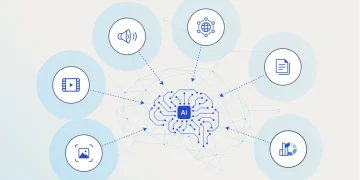Introduction
In today’s rapidly evolving global marketplace, the efficiency and cost-effectiveness of supply chains have become paramount. Supply chains, which encompass the entire lifecycle of a product from raw materials to final delivery to the consumer, are complex and often involve numerous variables that can be difficult to predict and manage. As businesses face increasing demands for faster delivery times, cost reductions, and sustainability, leveraging advanced technologies like Artificial Intelligence (AI) has become essential.
AI, with its capabilities in data processing, predictive analytics, machine learning (ML), and automation, offers enormous potential to revolutionize supply chains. The ability of AI to analyze vast amounts of data in real-time, predict demand, optimize routing, and automate tasks makes it an indispensable tool for companies seeking to enhance operational efficiency and reduce costs. AI can streamline operations, improve decision-making, and increase agility within supply chains, giving companies a competitive edge.
This article explores the application of AI in supply chains and highlights several success stories where AI has been implemented to improve efficiency and reduce costs. Through a detailed analysis of these case studies, we will see how AI is transforming industries like logistics, manufacturing, inventory management, and demand forecasting.
Section 1: AI in Demand Forecasting and Inventory Management
One of the most critical challenges in supply chain management is accurately predicting demand and managing inventory levels. Historically, companies have relied on traditional forecasting methods that often lead to either stockouts (when demand exceeds supply) or overstocking (resulting in excess inventory). AI-driven tools, however, can analyze historical data, track real-time trends, and adapt to changing conditions to predict future demand with a high degree of accuracy.
The Role of AI in Demand Forecasting
AI-powered demand forecasting involves the use of machine learning algorithms that analyze historical data, sales trends, seasonality, and other external factors to generate highly accurate predictions for future demand. By taking into account various factors such as promotions, economic indicators, and weather patterns, AI can identify complex relationships that humans might overlook.
Case Study: Walmart’s Use of AI for Demand Forecasting
Walmart, the world’s largest retailer, has implemented AI in its demand forecasting systems. By leveraging machine learning models, Walmart is able to predict customer demand with greater precision across its network of thousands of stores and warehouses. The AI system processes data from various sources, including point-of-sale systems, online transactions, and historical sales patterns, to make more accurate predictions about which products are likely to sell well in the future.
This enhanced forecasting capability enables Walmart to optimize inventory levels, ensuring that popular products are always in stock while reducing overstocking of less popular items. By improving demand visibility and managing stock levels more efficiently, Walmart has significantly reduced its operational costs and improved customer satisfaction.
Impact: AI-driven demand forecasting helps companies like Walmart minimize stockouts, reduce excess inventory, and optimize product replenishment, leading to cost savings and improved customer experiences.
AI in Inventory Optimization
Once demand forecasting is improved, the next challenge is optimizing inventory. AI can enhance inventory management by determining the optimal quantity of products to hold at various stages of the supply chain. This ensures that products are available when needed, but without tying up excessive capital in unsold inventory.
Case Study: Amazon’s AI for Inventory Optimization
Amazon, the global e-commerce giant, uses AI to manage its vast inventory of products. Through its advanced AI algorithms, Amazon can predict demand for millions of products across its warehouses and fulfillment centers. The company uses AI to determine the ideal inventory levels at each fulfillment center, ensuring that products are stored in locations where they are most likely to be needed.
Amazon’s AI system constantly analyzes real-time sales data, adjusting inventory levels dynamically to respond to fluctuations in demand. In addition, the AI system helps optimize the distribution of products across its global network of warehouses, reducing shipping costs and delivery times.
Impact: Amazon’s use of AI in inventory optimization has allowed it to achieve faster shipping times, lower operational costs, and more efficient use of warehouse space. By managing inventory levels more precisely, Amazon ensures that it can meet customer demands promptly, contributing to its success as a market leader.
Section 2: AI in Logistics and Transportation
Logistics and transportation are central to supply chain operations, as goods need to be moved from suppliers to manufacturers, then to warehouses and eventually to consumers. AI has significantly improved the efficiency of logistics by optimizing routes, reducing fuel consumption, and ensuring timely deliveries.
AI-Powered Route Optimization
AI can analyze traffic patterns, weather data, delivery schedules, and other variables to determine the most efficient routes for transporting goods. This not only reduces transportation costs but also improves delivery reliability and customer satisfaction.
Case Study: UPS and AI-Based Route Optimization
United Parcel Service (UPS) has long been a pioneer in the use of AI for logistics optimization. The company has implemented an AI-driven system called ORION (On-Road Integrated Optimization and Navigation) to optimize delivery routes for its fleet of trucks. ORION uses machine learning algorithms to analyze a variety of data points, including traffic conditions, package delivery times, and customer preferences, to calculate the most efficient delivery routes.
As a result, UPS has been able to reduce fuel consumption and carbon emissions, lower operational costs, and improve delivery times. The ORION system has saved UPS millions of dollars annually by minimizing miles traveled and improving the overall efficiency of its delivery network.
Impact: UPS’s use of AI in route optimization has not only reduced transportation costs but also improved environmental sustainability. By optimizing delivery routes, UPS has been able to offer more reliable services to customers while minimizing its operational footprint.
AI for Autonomous Vehicles in Transportation
Another groundbreaking development in AI for logistics is the use of autonomous vehicles (AVs). Self-driving trucks and drones have the potential to revolutionize supply chains by reducing reliance on human drivers, increasing efficiency, and lowering costs.
Case Study: Waymo’s Autonomous Delivery Solutions
Waymo, a subsidiary of Alphabet (Google’s parent company), is at the forefront of autonomous vehicle technology. The company has been developing autonomous trucks capable of transporting goods without the need for human drivers. Waymo’s AI-powered vehicles use advanced sensors, machine learning, and real-time data to navigate roadways, optimize routes, and deliver goods safely and efficiently.
Several companies are already testing autonomous delivery solutions, with Waymo leading the charge. These vehicles can operate 24/7 without rest, reducing delivery times and increasing supply chain productivity.
Impact: Autonomous vehicles powered by AI could disrupt traditional transportation models by offering faster, more cost-effective, and environmentally friendly delivery options. In the future, autonomous trucks and drones will play a significant role in the efficiency of global supply chains.

Section 3: AI in Supplier and Vendor Management
AI is also improving the relationship between businesses and their suppliers or vendors. AI tools help companies make better decisions when selecting suppliers, negotiate better contracts, and enhance the overall supplier relationship.
AI in Supplier Selection and Risk Management
AI can help businesses evaluate potential suppliers by analyzing their historical performance, financial stability, and reputation. This helps companies select suppliers that are most likely to deliver high-quality goods and services on time.
Case Study: IBM’s AI-Driven Supplier Relationship Management
IBM uses AI to enhance supplier relationship management (SRM). The company’s AI-powered SRM platform analyzes data from multiple sources, including supplier performance, market conditions, and geopolitical factors, to help IBM select suppliers that best align with its business goals.
This AI system can also assess supplier risk by evaluating the likelihood of delays, quality issues, or other disruptions that could affect the supply chain. By using AI to make data-driven decisions, IBM can strengthen its supplier relationships and ensure the continuity of its operations.
Impact: AI helps companies identify the best suppliers, optimize procurement strategies, and minimize the risks associated with supply chain disruptions. This ensures smoother operations and helps build long-term, sustainable relationships with key suppliers.
Section 4: The Future of AI in Supply Chains
As AI continues to evolve, its role in supply chain management will only expand. In the future, AI-driven technologies will enable even greater levels of automation, efficiency, and customization. We can expect advancements in areas such as:
- Predictive Supply Chain Analytics: AI systems will become even better at predicting disruptions in the supply chain, from natural disasters to geopolitical shifts, allowing businesses to proactively respond.
- Blockchain and AI Integration: Blockchain technology will work alongside AI to create more transparent and secure supply chains, ensuring traceability and reducing fraud.
- Collaborative AI: AI systems will work together across companies, industries, and regions to optimize entire supply chain networks, driving further efficiencies on a global scale.
Conclusion
AI is playing a transformative role in enhancing the efficiency and reducing the costs of supply chains across industries. From improving demand forecasting and inventory management to optimizing logistics and transportation, AI-driven technologies are helping companies create more agile, responsive, and cost-effective supply chains. Through real-world success stories like those of Walmart, Amazon, UPS, and IBM, we see how AI is enabling businesses to make smarter, data-driven decisions that result in improved operational performance and reduced overheads.
As AI continues to advance, its applications in supply chain management will undoubtedly evolve, leading to even greater efficiencies and cost savings for organizations worldwide. Embracing AI is no longer just an option—it is a necessity for businesses looking to stay competitive in an increasingly globalized and digital marketplace.











































